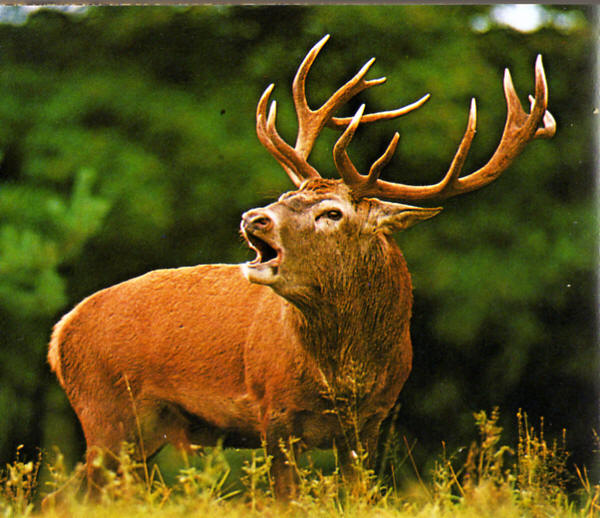
Red deer(Cervus elaphus)
Phylum —chordata
Class — mammalia
Order — artiodactyla
Family — cervidae
Genus – cervus
Appearance
The male (stag) red deer is typically 175 to 250 cm (69 to 98 in) long and weighs 160 to 240 kg (350 to 530 lb); the female (hind) is 160 to 210 cm (63 to 83 in) long and weighs 120 to 170 kg (260 to 370 lb).
Its coat is reddish brown, darkening to grayish brown in winter, with lighter underparts and a light rump.
Only the stags have antlers, which start growing in the spring and are shed each year, usually at the end of winter. Antlers typically measure 71 cm (28 in) in total length and weigh 1 kg (2.2 lb), although large ones can grow to 115 cm (45 in) and weigh 5 kg (11 lb). Antlers, which are made of bone, can grow at a rate of 2.5 cm (1 in) a day.
Habitat
The red deer inhabits most of Europe, the Caucasus Mountains region, Asia Minor, Iran, parts of western Asia, and central Asia. It also inhabits the Atlas Mountains region between Morocco and Tunisia in northwestern Africa, being the only species of deer to inhabit Africa. Red deer have been introduced to other areas, including Australia, New Zealand, United States, Canada, Peru, Uruguay, Chile and Argentina.
Behavior
These deer are social animals, living in summer herds with up to 400 individuals. The herds are matriarchal, being dominated by a single female. Seasonal migrations occur, with deer moving to higher elevations for the summer, and to lower elevations over winter. In spring, the sexes separate after the mating season, females leaving to give birth, bulls forming separate summer herds. Bulls during the mating season are territorial, and otherwise are not aggressive towards other deer.
Red deer browse early in the morning and late evening. During the day and late at night they are inactive, spending most of this time chewing their cud.
Diet
Red deer are browsers, eating grasses, forbs and sedges in summer, and, in winter, woody growth (cedar, wintergreen, sumac, eastern hemlock, jack pine, staghorn, red maple and basswood). Deer particularly like dandelions, aster, hawkweed, clover, violets and sometimes mushroom. Deer are ruminants, regurgitating their food and chewing it up again (i.e. chewing their cud) to aid digestion.
Reproduction
Female red deer reach sexual maturity at 2 years of age. Red deer mating patterns usually involve a dozen or more mating attempts before the first successful one. There may be several more matings before the stag will seek out another mate in his harem. Red deer are among the mammals exhibiting homosexual behavior.
The gestation period is 240 to 262 days, and the offspring weigh about 15 kg (33 lb). After two weeks, calves are able to join the herd and are fully weaned after two months. All red deer calves are born spotted, as is common with many deer species, and lose their spots by the end of summer. However, some adults do retain a few spots on the backs of their summer coats. The offspring will remain with their mothers for almost one full year, leaving around the time the next season's offspring are produced.
Red deer live over 20 years in captivity and in the wild they live 10 to 13 years.
In captivity
Red deer require similar care to elk and other large cervids. They need secure fencing, and plenty of space to exercise. Because they are social animals, they also need to live in small herds.
Their habitats should have plenty of grass and plants for them to browse on. Keepers also feed them pelleted feed, hay, mineral supplements, fruits, and vegetables.
 Russian
Russian
 English
English























